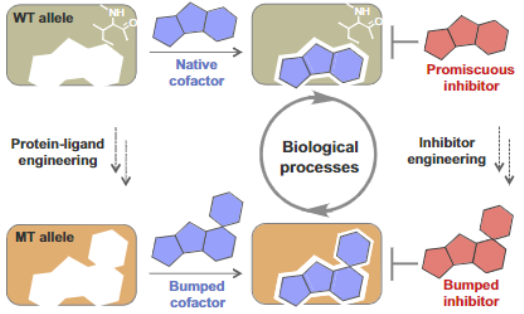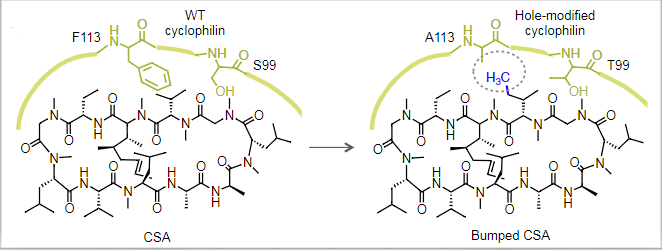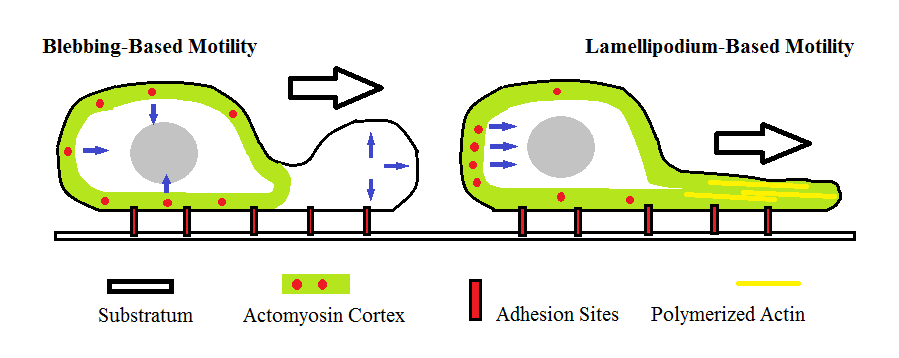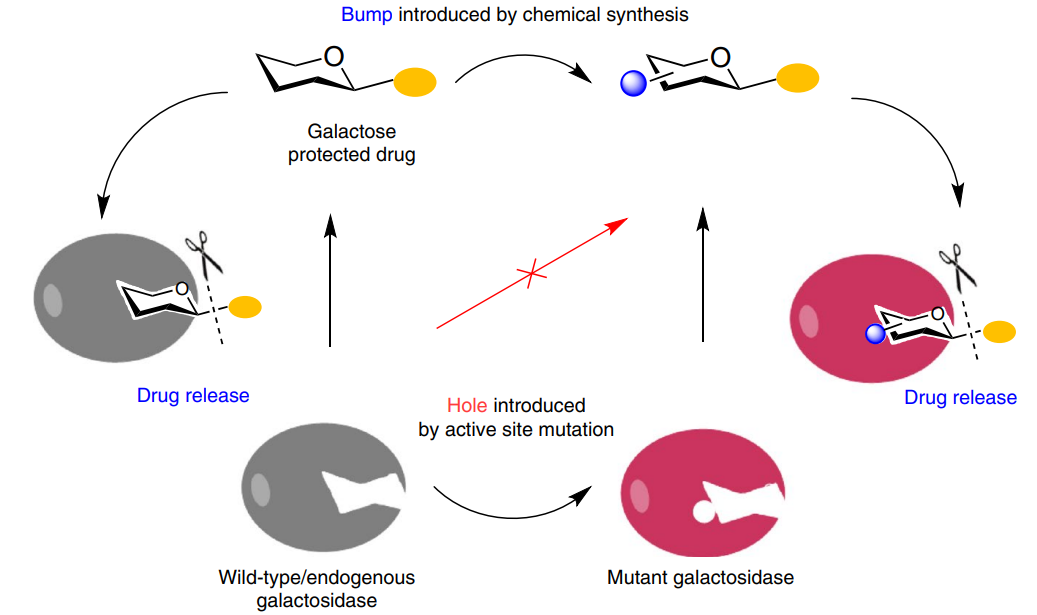Bump And Hole on:
[Wikipedia]
[Google]
[Amazon]
 The bump-and-hole method is a tool in
The bump-and-hole method is a tool in
 The first bump-and-hole pair, developed by Stuart Schreiber and colleagues, was a bumped cyclosporin A small-molecule with an Ile replacing Val at position 11, and a hole-modified (S99T/F113A) cyclophilin mutant. Cyclosporin A is a chemical inducer of dimerization (CID) of cyclophilin. This first bump-and-hole pair was engineered to improve the binding efficiency between wild type cyclosporin A and cyclophilin, thereby giving more efficient CID. The bumped cyclosporin A was found to interact efficiently with the hole-modified cyclophilin mutant, but not endogenous cyclophilin. The orthogonal CID pair was used to inhibit calcineurin-mediated dephosphorylation of nuclear factor of activated T cells in a cell- and tissue-specific manner. More recently, this first bump-and-hole pair was used to induce the assembly of
The first bump-and-hole pair, developed by Stuart Schreiber and colleagues, was a bumped cyclosporin A small-molecule with an Ile replacing Val at position 11, and a hole-modified (S99T/F113A) cyclophilin mutant. Cyclosporin A is a chemical inducer of dimerization (CID) of cyclophilin. This first bump-and-hole pair was engineered to improve the binding efficiency between wild type cyclosporin A and cyclophilin, thereby giving more efficient CID. The bumped cyclosporin A was found to interact efficiently with the hole-modified cyclophilin mutant, but not endogenous cyclophilin. The orthogonal CID pair was used to inhibit calcineurin-mediated dephosphorylation of nuclear factor of activated T cells in a cell- and tissue-specific manner. More recently, this first bump-and-hole pair was used to induce the assembly of
 Human protein kinases use
Human protein kinases use
 The
The
 Glycosidases are a family of enzymes that catalyzes the hydrolysis of
Glycosidases are a family of enzymes that catalyzes the hydrolysis of
 The ''N-''Acetylgalactosaminyl transferase (GalNac Ts) family transfers N-Acetylgalactosamine to the Ser/Thr side chains (
The ''N-''Acetylgalactosaminyl transferase (GalNac Ts) family transfers N-Acetylgalactosamine to the Ser/Thr side chains (
 The bump-and-hole method is a tool in
The bump-and-hole method is a tool in chemical genetics Chemical genetics is the investigation of the function of proteins and signal transduction pathways in cells by the screening of chemical libraries of small molecules. Chemical genetics is analogous to classical genetic screen where random mutations ...
for studying a specific isoform
A protein isoform, or "protein variant", is a member of a set of highly similar proteins that originate from a single gene or gene family and are the result of genetic differences. While many perform the same or similar biological roles, some isof ...
in a protein family without perturbing the other members of the family. The unattainability of isoform-selective inhibition due to structural homology in protein families is a major challenge of chemical genetics. With the bump-and-hole approach, a protein–ligand interface is engineered to achieve selectivity through steric
Steric effects arise from the spatial arrangement of atoms. When atoms come close together there is a rise in the energy of the molecule. Steric effects are nonbonding interactions that influence the shape ( conformation) and reactivity of ions ...
complementarity while maintaining biochemical competence and orthogonality to the wild type pair. Typically, a "bumped" ligand/inhibitor analog is designed to bind a corresponding "hole-modified" protein. Bumped ligands are commonly bulkier derivatives of a cofactor of the target protein. Hole-modified proteins are recombinantly expressed with an amino acid substitution from a larger to smaller residue, e.g. glycine or alanine, at the cofactor binding site. The designed ligand/inhibitor has specificity for the engineered protein due to steric complementarity, but not the native counterpart due to steric interference.
History
Inspiration for the bump-and-hole method was drawn from mutantE. coli
''Escherichia coli'' (),Wells, J. C. (2000) Longman Pronunciation Dictionary. Harlow ngland Pearson Education Ltd. also known as ''E. coli'' (), is a Gram-negative, facultative anaerobic, rod-shaped, coliform bacterium of the genus ''Escher ...
strains which carried an A294S mutant version of phenylalanine tRNA synthetase
An aminoacyl-tRNA synthetase (aaRS or ARS), also called tRNA-ligase, is an enzyme that attaches the appropriate amino acid onto its corresponding tRNA. It does so by catalyzing the transesterification of a specific cognate amino acid or its pre ...
and survived exposure to ''p''-FluoroPhe, a slightly bumped phenylalanine analog which is cytotoxic when incorporated in translation
Translation is the communication of the Meaning (linguistic), meaning of a #Source and target languages, source-language text by means of an Dynamic and formal equivalence, equivalent #Source and target languages, target-language text. The ...
. The A294S mutant strain was able to incorporate Phe, but not the bumped ''p''-FluoroPhe due to steric crowding from the hydroxymethylene of S294. Later work in the labs of Peter G. Schultz
Peter G. Schultz (born June 23, 1956) is an American chemist. He is the CEO and Professor of Chemistry at The Scripps Research Institute, the founder and former director of GNF, and the founding director of the California Institute for Biomedi ...
and David A. Tirrell showed that a hole-modified A294G phenylalanine tRNA synthetase mutant was able to incorporate the bumped ''p''-FluoroPhe in translation, demonstrating that steric manipulation can successfully broaden substrate scope, even for the highly specific aminoacyl synthetase.
 The first bump-and-hole pair, developed by Stuart Schreiber and colleagues, was a bumped cyclosporin A small-molecule with an Ile replacing Val at position 11, and a hole-modified (S99T/F113A) cyclophilin mutant. Cyclosporin A is a chemical inducer of dimerization (CID) of cyclophilin. This first bump-and-hole pair was engineered to improve the binding efficiency between wild type cyclosporin A and cyclophilin, thereby giving more efficient CID. The bumped cyclosporin A was found to interact efficiently with the hole-modified cyclophilin mutant, but not endogenous cyclophilin. The orthogonal CID pair was used to inhibit calcineurin-mediated dephosphorylation of nuclear factor of activated T cells in a cell- and tissue-specific manner. More recently, this first bump-and-hole pair was used to induce the assembly of
The first bump-and-hole pair, developed by Stuart Schreiber and colleagues, was a bumped cyclosporin A small-molecule with an Ile replacing Val at position 11, and a hole-modified (S99T/F113A) cyclophilin mutant. Cyclosporin A is a chemical inducer of dimerization (CID) of cyclophilin. This first bump-and-hole pair was engineered to improve the binding efficiency between wild type cyclosporin A and cyclophilin, thereby giving more efficient CID. The bumped cyclosporin A was found to interact efficiently with the hole-modified cyclophilin mutant, but not endogenous cyclophilin. The orthogonal CID pair was used to inhibit calcineurin-mediated dephosphorylation of nuclear factor of activated T cells in a cell- and tissue-specific manner. More recently, this first bump-and-hole pair was used to induce the assembly of ten-eleven translocation 2
Tet methylcytosine dioxygenase 2 (''TET2'') is a human gene. It resides at chromosome 4q24, in a region showing recurrent microdeletions and copy-neutral loss of heterozygosity (CN-LOH) in patients with diverse myeloid malignancies.
Function
' ...
dioxygenase in cells for temporally controlled DNA demethylation
For molecular biology in mammals, DNA demethylation causes replacement of 5-methylcytosine (5mC) in a DNA sequence by cytosine (C) (see figure of 5mC and C). DNA demethylation can occur by an active process at the site of a 5mC in a DNA sequenc ...
.
Applications
As structural information about protein-ligand interfaces have become available, bump-and-hole pairs have been used to elucidate the substrates of specific proteins from various protein classes, as well as develop orthogonal neoenzyme-neosubstrate therapeutics.Kinases
 Human protein kinases use
Human protein kinases use ATP
ATP may refer to:
Companies and organizations
* Association of Tennis Professionals, men's professional tennis governing body
* American Technical Publishers, employee-owned publishing company
* ', a Danish pension
* Armenia Tree Project, non ...
as a cofactor to phosphorylate substrate proteins. Kinases play critical roles in complex cell signaling networks. Conserved ATP binding sites and similar catalytic mechanisms pose a challenge to selectively inhibiting a particular kinase to determine its function. Kevan Shokat's lab has developed bump-and-hole pairs using kinase mutants with bulky "gatekeeper" residues in the ATP-binding pocket replaced by Gly or Ala, and bulky ATP analogs. In early work, v-Src kinase I338A/G mutants were shown to accept �-32Plabeled bumped N6-cyclopentyl and N6-benzyl ATP analogs as alternative cofactors to radiolabel its substrates. Only the mutant kinase was able to bind the bumped ATP analogs, allowing labeling of substrates specific to the engineered v-Src kinase. Purification and MS-based proteomics yielded the substrates of v-Src kinase. Hole-modified kinase and bumped ATP analog pairs enabled substrate profiling of several other kinases, including CDK1, Pho85, ERK2
Mitogen-activated protein kinase 1, (MAPK 1), also known as ERK2, is an enzyme that in humans is encoded by the ''MAPK1'' gene.
Function
The protein encoded by this gene is a member of the MAP kinase family. MAP kinases, also known as extrace ...
, and JNK.
While bumped ATM analogs can help deconvolute kinase substrate profiles, one drawback of this strategy is the cell impermeability of the bumped analogs. To get around this, the Shokat group demonstrated that a bumped ATP analog, kinetin ATP or KTP, could be synthesized endogenously in cells cultured with kinetin
Kinetin (/'kaɪnɪtɪn/) is a type of cytokinin, a class of plant hormone that promotes cell division. Kinetin was originally isolated by Carlos Miller and Skoog ''et al.'' as a compound from autoclaved herring sperm DNA that had cell division- ...
. Once synthesized, it can activate a PINK1
PTEN-induced kinase 1 (PINK1) is a mitochondrial serine/threonine-protein kinase encoded by the ''PINK1'' gene.
It is thought to protect cells from stress-induced mitochondrial dysfunction. PINK1 activity causes the parkin protein to bind to d ...
kinase mutant, which is otherwise inactive in the absence of the bumped analog. Inactive PINK1 is implicated in Parkinson's disease
Parkinson's disease (PD), or simply Parkinson's, is a long-term degenerative disorder of the central nervous system that mainly affects the motor system. The symptoms usually emerge slowly, and as the disease worsens, non-motor symptoms becom ...
(PD). In the context of PD, the mutant PINK1-KTP pair represents an orthogonal neoenzyme-neosubstrate therapeutic.
The Shokat group also applied the bump-and-hole approach to develop selective, cell-permeable bumped inhibitors of mutant kinases. For the I338G v-Src kinase, a 4-amino-l-''tert''-butyl-3-(''p''-methylphenyl)pyrazolo ,4-dyrimidine (PP1) derivative called ''p''-tButPhe-PP1 was developed for selective inhibition; steric bulk precluded binding to the wild type v-Src kinase. In mammalian cell lines, active v-Src kinase is required for transformation by Rous sarcoma virus. In cell lines expressing I338G v-Src kinase and transfected with RSV, treatment with ''p''-tButPhe-PP1 caused the reversal of transformation, suggesting inhibition of the kinase mutant. Later, the group developed bumped inhibitors 1-naphthyl PP1 (NA-PP1) and 1-methylnaphthyl PP1 (MN-PP1), which inhibited hole-modified yeast kinases with IC50 values in low nanomolar concentrations.
BET proteins
 The
The BET
Black Entertainment Television (acronym BET) is an American basic cable channel targeting African-American audiences. It is owned by the CBS Entertainment Group unit of Paramount Global via BET Networks and has offices in New York City, Los A ...
(Bromodomains and Extra Terminal) family of proteins contain conserved motifs known as bromodomains (BDs) responsible for recognizing acetylated
:
In organic chemistry, acetylation is an organic esterification reaction with acetic acid. It introduces an acetyl group into a chemical compound. Such compounds are termed ''acetate esters'' or simply ''acetates''. Deacetylation is the opposi ...
lysine on nucleosomal histones. Recently, four members of the BET family, BRD2, 3, 4, and BRDT, each containing two bromodomains, were identified as important regulators of transcription. In order to probe bromodomain-specific functions of members of the BET family, small-molecule inhibitors JQ1 and I-BET were developed, but they lacked inter- and intra-BET (between BDs on the same protein) selectivity. The lab of Alessio Ciulli produced bump-and-hole pairs consisting of ET, a derivative of I-BET with an ethyl bump, and different members of the BET family with an L94A mutation in their BD1. ET was found to have a 160-fold greater specificity for hole-modified BD1 of BET mutants compared to compared to the BDs of wild type BET proteins, giving BD-specific inhibition. The BD-ET bump-and-hole pairs were used to show that selective inhibition of BD1 in a BET protein disrupts chromatin engagement. Recently, the Ciulli group developed a new bump-and-hole pair consisting of BET mutants with a Leu to Val mutation in a BD and the bumped small-molecule inhibitor 9-ME-1. This bumped inhibitor was found to have an IC50 of 200nM and over 100-fold specificity for the L/V BET mutant BD over wild type BDs. This bump-and-hole pair allowed selective inhibition of specific BDs in specific BET proteins, elucidating their role in human cells. It was found that while BD1 is important for chromatin localization of BET proteins, BD2 regulates gene expression by binding and recruiting non-histone acetylated proteins, such as transcription factors.
Glycosidases
 Glycosidases are a family of enzymes that catalyzes the hydrolysis of
Glycosidases are a family of enzymes that catalyzes the hydrolysis of glycosidic bonds
A glycosidic bond or glycosidic linkage is a type of covalent bond that joins a carbohydrate (sugar) molecule to another group, which may or may not be another carbohydrate.
A glycosidic bond is formed between the hemiacetal or hemiketal grou ...
. These enzymes can cleave glycans from glycosylated
Glycosylation is the reaction in which a carbohydrate (or 'glycan'), i.e. a glycosyl donor, is attached to a hydroxyl or other functional group of another molecule (a glycosyl acceptor) in order to form a glycoconjugate. In biology (but not alw ...
proteins, one of the most common forms of post-translational modification
Post-translational modification (PTM) is the covalent and generally enzymatic modification of proteins following protein biosynthesis. This process occurs in the endoplasmic reticulum and the golgi apparatus. Proteins are synthesized by ribosome ...
. In a recent therapeutic application of the bump-and-hole method, a hole-modified galactosidase Galactosidases are enzymes (glycoside hydrolases) that catalyze the hydrolysis of galactosides into monosaccharides.
Galactosides can be classified as either alpha or beta. If the galactoside is classified as an alpha-galactoside, the enzyme is cal ...
was paired with a bumped galactosyl-pro-drug. Jingli Hou and colleagues sought to deliver nitric oxide
Nitric oxide (nitrogen oxide or nitrogen monoxide) is a colorless gas with the formula . It is one of the principal oxides of nitrogen. Nitric oxide is a free radical: it has an unpaired electron, which is sometimes denoted by a dot in its che ...
, an important messenger for promoting tissue growth processes like angiogenesis
Angiogenesis is the physiological process through which new blood vessels form from pre-existing vessels, formed in the earlier stage of vasculogenesis. Angiogenesis continues the growth of the vasculature by processes of sprouting and splitting ...
and vasculogenesis
Vasculogenesis is the process of blood vessel formation, occurring by a '' de novo'' production of endothelial cells. It is sometimes paired with angiogenesis, as the first stage of the formation of the vascular network, closely followed by angio ...
, in a spatiotemporally controlled manner. They opted for a pro-drug
A prodrug is a medication or compound that, after intake, is metabolized (i.e., converted within the body) into a pharmacologically active drug. Instead of administering a drug directly, a corresponding prodrug can be used to improve how the drug ...
system, wherein the NO-releasing drug, NONOate, is initially glycosylated. Once the glycosylated NONOate enters cells and is exposed to glycosidases, NO is released. However, non-tissue-specific systemic release of NO, which can reduce therapeutic efficiency and cause harmful side effects, from these pro-drugs was evident due to widespread distribution of endogenous glycosidases. To get around this, Hou et al. developed a bumped pro-drug via methylation
In the chemical sciences, methylation denotes the addition of a methyl group on a substrate, or the substitution of an atom (or group) by a methyl group. Methylation is a form of alkylation, with a methyl group replacing a hydrogen atom. These t ...
of the O6 of the galactose moiety of galactosyl-NONOate. They engineered a corresponding hole-modified β-galactosidase mutant, A4-β-GalH363A with specificity for the bumped galactosyl-NONOate. The bumped pro-drug evaded cleavage by wild type β-galactosidase due to the methylated O6 of the galactose moiety and strict regioselectivity of glycosidases. NO was released in tissues only in the presence of both the bumped galactosyl-NONOate and the hole-modified β-galactosidase mutant, giving spatiotemporal control of delivery. Hou et al. found markedly increased therapeutic efficiency of NO delivery via the bump-and-hole engineered system, compared to the unmodified pro-drug, in rat hindlimb ischemia
Ischemia or ischaemia is a restriction in blood supply to any tissue, muscle group, or organ of the body, causing a shortage of oxygen that is needed for cellular metabolism (to keep tissue alive). Ischemia is generally caused by problems wi ...
and mouse acute kidney injury models.
''N''-Acetylgalactosaminyl transferases
 The ''N-''Acetylgalactosaminyl transferase (GalNac Ts) family transfers N-Acetylgalactosamine to the Ser/Thr side chains (
The ''N-''Acetylgalactosaminyl transferase (GalNac Ts) family transfers N-Acetylgalactosamine to the Ser/Thr side chains (O-linked glycosylation
''O''-linked glycosylation is the attachment of a sugar molecule to the oxygen atom of serine (Ser) or threonine (Thr) residues in a protein. ''O''-glycosylation is a post-translational modification that occurs after the protein has been synthesise ...
) of its substrates, using UDP-GalNac as a cofactor. Like kinases, substrate profiling for specific isoforms of GalNac Ts has been difficult to achieve. The absence of a glycosylation consensus sequence and the variability of glycan elaboration pose a challenge to studying O-GalNac glycoproteins. Further, GalNac transferase knockout strategies are ineffective because the activity of isoforms in the family is both redundant and competitive, such that compensation occurs upon KO. Recently, Schumann et al. applied the bump-and-hole strategy to engineer bumped alkyne-containing UDP-GalNac analogs and double hole-modified I253A/L310A mutant GalNac Ts (BH GalNac Ts). The UDP-alkyne analogs were specific to complementary BH GalNac Ts, which were shown to maintain the biochemical competence of wild type GalNac Ts, with regards to structure, localization, and substrate specificity. This bump-and-hole pair attached a bio-orthogonal label, visualizable through click chemistry
In chemical synthesis, click chemistry is a class of biocompatible small molecule reactions commonly used in bioconjugation, allowing the joining of substrates of choice with specific biomolecules. Click chemistry is not a single specific reaction ...
, on the substrates of distinct GalNac T isoforms, deconvolving substrate profiles while displaying complexity of glycan elaboration in the secretory pathway.
References
{{reflist Genetics Homology theory Human proteins